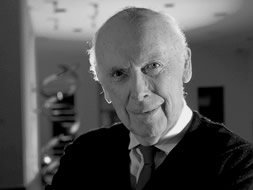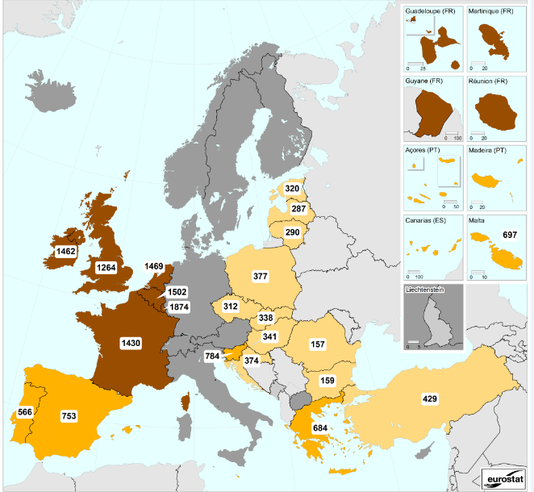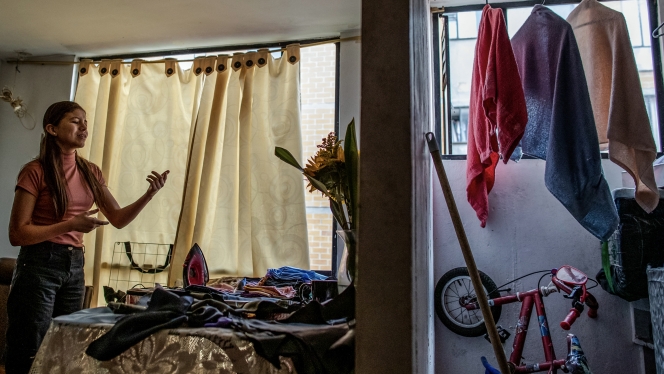What percentage of your brain do you use?
↧
↧
Nicolas Perony: Puppies! Now that I’ve got your attention, complexity theory
SpeakersNicolas Perony: Animal scientist

Why you should listen to him:
Nicolas Perony started his career as a roboticist. But after one of his robots -- which was designed to follow a white line -- destroyed itself because of a lighting snafu on demo day, he realized that he was less interested in creating complicated robots and more interested in studying the complexity that already exists out there in the animal kingdom. He quickly changed course and is now a quantitative scientist at the Chair of Systems Design at ETH Zurich, where he studies the structure and dynamics of animal societies.
Perony conducts his research by placing GPS collars on animals like Bechstein's bats and meerkats, and studying the spacial data of the group. He creates models of the movement over time to see patterns. He then tries to ascertain at the simple rules that individuals in the animal group seem to be following that, when done en masse, result in the larger flow. In other words, he looks at the underlying mechanics that lead to the collective movement of animal groups.↧
Frederic Kaplan: How to build an information time machine
SpeakersFrederic Kaplan: Digital humanities researcher

Why you should listen to him:
Kaplan holds a PhD in artificial intelligence from the University Paris VI. He lives in Switzerland
↧
James Watson sur comment il a découvert l'ADN
SpeakersJames Watson: Biologist, Nobel laureate

Why you should listen to him:
Watson and Crick's 1953 discovery of DNA's double-helix structure paved the way for the astounding breakthroughs in genetics and medicine that marked the second half of the 20th century. And Watson's classic 1968 memoir of the discovery, The Double Helix, changed the way the public perceives scientists, thanks to its candid account of the personality conflicts on the project.
From 1988 to 1994, he ran the Human Genome Project. His current passion is the quest to identify genetic bases for major illnesses; in 2007 he put his fully sequenced genome online, the second person to do so, in an effort to encourage personalized medicine and early detection and prevention of diseases.
Read more about James Watson on the TED Blog »
↧
Où se réfugier en cas d’attaque nucléaire Où se réfugier en cas d'attaque nucléaire

Cette fois, on y est ! L’impensable est arrivé. Une bombe nucléaire vient d’exploser non loin de là où vous vivez. Que faire pour espérer y survivre ? Rassurez-vous, le gouvernement américain a publié un guide pour exhorter ses habitants à rejoindre, le plus rapidement, le meilleur des abris.
Si vous êtes dans un rayon de 1 à 2km, bien évidemment, il sera difficile de faire quoi que ce soit. A partir de 2km cela dit, les bâtiments ne subissent majoritairement que quelques dégâts. L’image ci-dessus, découverte par Erika Engelhaupt, présente les meilleurs endroits où se réfugier en cas de détonation nucléaire. Sans surprise, les sous-sols sont privilégiés, pourvu qu’ils soient entourés de béton. D’une manière générale, préférez un « abri lui-même à l’abri », la pièce ou le logement le moins en contact avec l’extérieur. Dans un immeuble, évitez ainsi le rez-de-chaussée, le dernier étage et les pièces les plus vitrées.
Le scientifique Michael B. Dillon du « Lawrence Livermore National Laboratory » s’est récemment intéressé aux facteurs déterminant les meilleurs abris possibles. Selon lui, parvenir à trouver un refuge adéquat permettrait de sauver entre 10 000 et 100 000 individus. Comme vous pouvez vous en douter, le facteur clef est ici le temps, vous n’aurez que quelques minutes pour vous protéger.
Ceci dit, si attaque nucléaire il y a, dans quel état retrouvera-t-on notre planète ?
Si vous êtes dans un rayon de 1 à 2km, bien évidemment, il sera difficile de faire quoi que ce soit. A partir de 2km cela dit, les bâtiments ne subissent majoritairement que quelques dégâts. L’image ci-dessus, découverte par Erika Engelhaupt, présente les meilleurs endroits où se réfugier en cas de détonation nucléaire. Sans surprise, les sous-sols sont privilégiés, pourvu qu’ils soient entourés de béton. D’une manière générale, préférez un « abri lui-même à l’abri », la pièce ou le logement le moins en contact avec l’extérieur. Dans un immeuble, évitez ainsi le rez-de-chaussée, le dernier étage et les pièces les plus vitrées.
Le scientifique Michael B. Dillon du « Lawrence Livermore National Laboratory » s’est récemment intéressé aux facteurs déterminant les meilleurs abris possibles. Selon lui, parvenir à trouver un refuge adéquat permettrait de sauver entre 10 000 et 100 000 individus. Comme vous pouvez vous en douter, le facteur clef est ici le temps, vous n’aurez que quelques minutes pour vous protéger.
Ceci dit, si attaque nucléaire il y a, dans quel état retrouvera-t-on notre planète ?
↧
↧
L’étonnante carte historique d’Internet carte internet

Naviguer sur Internet demande de connaître les océans de l’information appelées Google, ou Wikipédia. Pour éviter de mouiller en terre de l’ennui, un petit tour par YouTube, 9Gag ou 4Chan est envisageable. Et comme personne n’aimerait se perdre dans la mer du proxy, avoir une carte d’Internetà jour est absolument indispensable surtout quand elle est aussi belle.
![carte internet Jay simons]()
Cliquez pour la voir en grand
Cette carte d’Internet a été réalisée par Jay Simons, un étudiant slovaque. Elle regroupe les 500 plus gros sites web du moment, une frise historique d’Internet, les plus grands développeurs de logiciels ainsi que 4 mini-cartes représentant la surveillance de la NSA, les réseaux sociaux les plus utilisés, et les navigateurs Internet les plus utilisés et la pénétration d’Internet.
Cette carte est actuellement en venteà des prix allant de 10 € à 80 € selon la taille. L’auteur nous prévient qu’il y a un grand nombre de sites web et de fabricants de logiciels qui seront ajoutés dans les prochaines versions de cette carte. C’est le genre de carte que je verrais bien dans la salle d’attente d’une SSII.

Cliquez pour la voir en grand
Cette carte d’Internet a été réalisée par Jay Simons, un étudiant slovaque. Elle regroupe les 500 plus gros sites web du moment, une frise historique d’Internet, les plus grands développeurs de logiciels ainsi que 4 mini-cartes représentant la surveillance de la NSA, les réseaux sociaux les plus utilisés, et les navigateurs Internet les plus utilisés et la pénétration d’Internet.
Cette carte est actuellement en venteà des prix allant de 10 € à 80 € selon la taille. L’auteur nous prévient qu’il y a un grand nombre de sites web et de fabricants de logiciels qui seront ajoutés dans les prochaines versions de cette carte. C’est le genre de carte que je verrais bien dans la salle d’attente d’une SSII.
↧
Europe - Salaire minimum (2013)

Source : Eurostat
↧
Un regard sur le braille
↧
Une incroyable nouvelle vidéo du saut de Felix Baumgartner

Vous avez tous vu Felix Baumgartner sauter de 39 000 mètres au-dessus de la surface de la Terre, mais vous ne l’avez encore jamais vu comme ça. Cette nouvelle vidéo nous montre le saut depuis le point de vue de Felix…. avec une qualité d’image impressionnante.
Allez directement à 1:40 pour avoir un peu d’action
En 2014, l’exploit n’a rien perdu de sa fraîcheur. Cette nouvelle perspective est ahurissante. Si vous la regardez en plein écran, vous aurez peut-être même l’impression de vertige.
Allez directement à 1:40 pour avoir un peu d’action
En 2014, l’exploit n’a rien perdu de sa fraîcheur. Cette nouvelle perspective est ahurissante. Si vous la regardez en plein écran, vous aurez peut-être même l’impression de vertige.
↧
↧
Une idée sur 2020 ?

De quoi l’avenir sera-t-il fait ? Quelles sont les prochaines technologies disruptives qui viendront bouleverser notre quotidien ? Quelles avancées la science aura-t-elle parcouru ? Les nombreux outils d’analyse prédictifs dont nous disposons actuellement ne sont pas assez fiables pour apporter une réponse précise à ces questions. Mais des suppositions peuvent toujours être formulées.
Ces suppositions sont en tout cas le sujet d’un livre intitulé Shift 2020, dont le financement a été assuré sur le site Kickstarter. Lancé en 2010, l’idée de son auteur était de réunir les avis de nombreux spécialistes afin de les motiver à réfléchir ensemble à l’avenir, et particulièrement, à ce qui pourrait nous attendre en 2020.
Résultat ? Un eBook de 80 pages (disponible aussi en version papier) au fil desquelles les experts ayant participé au projet présentent leur vision de l’avenir.
Au programme en 2020, si nous en croyons les dires de cet ouvrage, il faudra par exemple s’attendre à ce que l’assistance des robots au quotidien se démocratise, mais aussi à ce que les monnaies alternatives tels que le Bitcoin soient acceptées par les gouvernements du monde entier, créant une économie parallèle globalisée.
Entre autre chose, les experts prévoient l’avènement des Smart cities, mais aussi le développement de la télépathie ou de la téléportation… On se retrouve en 2020 pour faire le tri.
Ces suppositions sont en tout cas le sujet d’un livre intitulé Shift 2020, dont le financement a été assuré sur le site Kickstarter. Lancé en 2010, l’idée de son auteur était de réunir les avis de nombreux spécialistes afin de les motiver à réfléchir ensemble à l’avenir, et particulièrement, à ce qui pourrait nous attendre en 2020.
Résultat ? Un eBook de 80 pages (disponible aussi en version papier) au fil desquelles les experts ayant participé au projet présentent leur vision de l’avenir.
Au programme en 2020, si nous en croyons les dires de cet ouvrage, il faudra par exemple s’attendre à ce que l’assistance des robots au quotidien se démocratise, mais aussi à ce que les monnaies alternatives tels que le Bitcoin soient acceptées par les gouvernements du monde entier, créant une économie parallèle globalisée.
Entre autre chose, les experts prévoient l’avènement des Smart cities, mais aussi le développement de la télépathie ou de la téléportation… On se retrouve en 2020 pour faire le tri.
↧
Somewhere Only We Know
↧
The Many Faces of Guilty Dogs
↧
Andrew Solomon: Depression, the secret we share
↧
↧
Dan Pink sur la surprenante science de la motivation
SpeakersDan Pink: Career analyst

Why you should listen to him:
His latest book, The Adventures of Johnny Bunko, is an evolutionary transformation of the familiar career guide. Replacing linear text with a manga-inspired comic, Pink outlines six career laws vastly differing from the ones you've been taught. Members of the Johnny Bunko online forum participated in an online contest to create the seventh law -- "stay hungry."
A contributing editor for Wired, Pink is working on a new book on the science and economics of motivation for release in late 2009.
"Pink has a knack for teaching in such an entertaining way that you'll forget you are learning."Lexi Feinberg, Forbes.com Read more about Dan Pink on the TED Blog »
↧
Où courent les Parisiens ?
Une carte répertorie les rues les plus utilisées par les joggeurs

Réponse : au centre et à la périphérie. Et puis dans les bois, ou encore le long des berges de Seine et du canal Saint-Martin, cela va de soi. Mais surtout, le plus important, cette carte démontre une chose que d'aucuns pensaient impossible... On peut courir à Paris.
> Pour voir la carte en grand (et plus de trajets de coureurs dans d'autres villes), cliquez ici.
↧
Give away

↧
Everything Is Connected
↧
↧
Jour de Colère !

↧
14 Juillet
↧
Amazing Herb Kills 98% Of Cancer Cells In Just 16 Hours
Taking in consideration it is one of the deadliest diseases, scientists constantly try to find a cure and finally put and end to cancer. This herb is one of those cures and it can kill up to 98% of cancer cells in just 16 hours.
Namely, according to the researches published in “Life Science”, artemisinin, a “Sweet wormwood” or “Artemisia Annua” derivative, was used in Chinese medicine and it can kill 98% of lung cancer cells in less than 16 hours.
The herb used by itself reduces lung cancer cells up to 28%, but in combination with iron, “Artemisia Annua” successfully and completely “erases” cancer, and in the experiment this herb had no impact on healthy lung cells.
![Amazing Herb Kills 98% Of Cancer Cells In Just 16 Hours]()
Image Credits
Artemisinin in past was used as a powerful antimalarial remedy, but now it is proven that this cure is also effective in the fight against cancer.
When scientists added iron while conducting the study, which later attached to lung tissue, especially to cancer infected cells, artemisinine selectively attacked “bad” cells, and left “good” cells untouched.
“In general, our results show that artemisinin stops ‘E2F1′ transcription factor and intervenes in destruction of lung cancer cells, meaning it presents a transcription way according to which artemisinin controls reproductive cancer cell growth”, was stated in the conclusion of the researches conducted in the cancer laboratory at the University of California.
There are numerous experiments conducted so far and they all prove that in combination with iron, artemisinin can effectively destroy cancer, and this extract was used in China for thousands of years, as a cure for malaria.
Malaria parasite can not survive in the presence of artemisinine, because it is rich in iron, and bio-engineers Henry Lai and Narendra Singh from the University of Washington were the first scientists to discover this.
Their research proved that cancer cells undergo an apoptosis, or self-destruction, and until this moment it was difficult to get the extract for more acceptable prices, but people show more and more interest in this herb, so the prices could get lower.
French medicine producer, “Sanofi”, announced that they expect production of 50 to 60 tones artemisinin every year, hoping that it will satisfy the needs of the world market.
Namely, according to the researches published in “Life Science”, artemisinin, a “Sweet wormwood” or “Artemisia Annua” derivative, was used in Chinese medicine and it can kill 98% of lung cancer cells in less than 16 hours.
The herb used by itself reduces lung cancer cells up to 28%, but in combination with iron, “Artemisia Annua” successfully and completely “erases” cancer, and in the experiment this herb had no impact on healthy lung cells.

Image Credits
Artemisinin in past was used as a powerful antimalarial remedy, but now it is proven that this cure is also effective in the fight against cancer.
When scientists added iron while conducting the study, which later attached to lung tissue, especially to cancer infected cells, artemisinine selectively attacked “bad” cells, and left “good” cells untouched.
“In general, our results show that artemisinin stops ‘E2F1′ transcription factor and intervenes in destruction of lung cancer cells, meaning it presents a transcription way according to which artemisinin controls reproductive cancer cell growth”, was stated in the conclusion of the researches conducted in the cancer laboratory at the University of California.
Iron deposits in cancer cells with special receptors which help in cell division. Normal cells also have these receptors, but cancer cells have them in larger amounts and according to this, cancer cells can be target combination of iron and artemisinin.
Malaria parasite can not survive in the presence of artemisinine, because it is rich in iron, and bio-engineers Henry Lai and Narendra Singh from the University of Washington were the first scientists to discover this.
Their research proved that cancer cells undergo an apoptosis, or self-destruction, and until this moment it was difficult to get the extract for more acceptable prices, but people show more and more interest in this herb, so the prices could get lower.
French medicine producer, “Sanofi”, announced that they expect production of 50 to 60 tones artemisinin every year, hoping that it will satisfy the needs of the world market.
↧
More Pages to Explore .....















